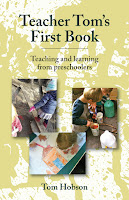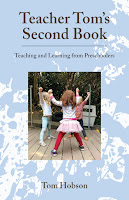Between the ages of 10-12 I attended an international school near Athens, Greece that had adopted a curriculum called IPI (Individually Prescribed Instruction). Upon entering fourth grade, I was handed two folders, one for math and one for English, and was told to work through them "at your own pace." Inside the folders I found a series of lessons that involved reading, exercises, then when you felt you knew the material, a test that you turned into the teacher for grading. If you passed, you were to move on to the next lesson. If you failed, you simply went back and did the reading and exercises again before once more taking the test. You took the test over and over until you passed it.
The idea was to allow children to work at their own pace. It was an acknowledgement that in any group of children a wide variety of abilities and understanding were represented. Looking back I see IPI as a strange hybrid that tried to be both standardized and personalized, but it at least had the virtue of recognizing the variability, even if we were all the same age. I know that many packaged curricula allow some individual flexibility, but IPI was unique, I think, in that we didn't get new folders at the beginning fifth grade or sixth. This wasn't the curriculum for one year, but for as long as it took.
The English material was easy for me. In fact, I discovered that I could skip directly to the test in most cases. This meant that I blazed through the entire curriculum before the end of that first school year. On the other hand, the math work was more of a struggle. I was still working on Level F Division halfway through my sixth grade year when my family moved back to the US. I don't know what would have happened had I remained stuck on that level into seventh grade, but I expect I would have continued working on it, probably with ever increasing support from teachers, because at some point I imagine that they would want me to move on to something else.
In some ways, as strange as those IPI years were in my educational journey, I look back on them as a kind of golden era of schooling in that once you completed your folder, you got to do "whatever you want" during those the IPI parts of the day. There were options like band (I tried out clarinet) or art (I spent a lot of time drawing), but you could also just chose to play: playing pick-up soccer or dodgeball, shooting marbles, or just goofing off. In other words, the school didn't feel the urge to fill those hours with "advanced" lessons or enrichment, but rather just let us be.
I'm sure there were debates among the adults behind the scenes over this policy. I have no doubt that some felt that we were wasting our time shooting marbles. But there must have been someone pushing back as well, adults who were saying, "Why can't we just let them play?" After all, we couldn't be falling behind because the entire concept behind IPI was that there was no behind.
Here's the thing: no matter how much the IPI concept tried to celebrate individuality and working at our own pace, we kids tended to rank ourselves according to the adult-created system, boasting about our levels, lying about our levels, judging others by their levels. What I loved most about having completed my entire English folder was that I suddenly felt free, free to play, but even more powerful, free from the ranking. Down there amidst the marbles, down on the floor under the desks and chairs, out there on the playground stirring up dust clouds, there were no levels. Maybe that was part of the program as well: maybe we, the free, were there to inspire the others who, if they worked hard enough, could join us.
From the perspective of academics, I'm sure IPI produced results as good, or better, than today's more stressful, drill-and-kill crap that tends to view the natural variability in ability and understanding as a problem, where falling behind is the worst of sins, both for the student and the teacher. Still, IPI nevertheless fell short in its hopes of finding a way to deliver adult-centered learning in a way that accommodated the natural variability among children.
The only learning model that truly embraces this is when the children are in charge of their own curriculum, when they are free to goof off. There is no falling behind. The curriculum is always just right for each child. It accommodates all that variability in ways that adult-centric learning never can. When children are trusted to devise their own course of study, when each child gets to choose what, how, and when they will do things, we that the children, as Russian psychiatrist Lev Vygotsky pointed out, are a head taller than themselves. "In play," he writes, "a child is always above his average age." In other words, learning at their highest capacity.
Of course, hierarchies (or levels) emerge in play, but they are of the ever-changing variety, elevating one child in this moment and another in the next depending on the nature of the self-selected activity. The child who can read is a head taller when reading is important to the game. The child who can tie knots has their moment when tying knots is needed. The child who can spin dramatic tales, the child who climbs well, the child who knows how to sooth others, the child who builds, the child who sings, the child who dances -- each has their moment. And together, linking strength to strength, ability to ability, understanding to understanding, the children create a curriculum that not only better reflects the real world outside of school, but more importantly, this specific community of children as they are, right now.
Adult-centered schooling simply cannot do this, no matter how progressive the curriculum. Adults will always create rankings. They will always require tests. They will always insist that all children perform, ignoring the natural variability in abilities and understanding. Child-centered learning has no need for rankings, grades or tests because the proof is always in the pudding as the children create their own, unique, collective understanding, each standing on the shoulders of others to see farther than any one of them can see alone.
******
If you liked reading this post, you might also enjoy one of my books. To find out more, Click here!
"Ready for a book that makes you want to underline and highlight? One that makes you draw arrows and write 'THIS!!!!!' in the margin? Then you are in for a treat." ~Lisa Murphy, M.Ed., author and Early Childhood Specialist, Ooey Gooey, Inc.
I put a lot of time and effort into this blog. If you'd like to support me please consider a small contribution to the cause. Thank you!



